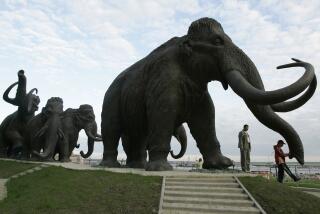Scientists ‘resurrect’ gene believed to have helped woolly mammoths tolerate cold
- Share via
No one has brought a woolly mammoth back from extinction, but a team of scientists has brought back a woolly mammoth gene, discovering that it and others unique to the long-vanished elephant-like beasts probably helped the animals withstand the harsh cold of the Arctic tundra.
The work helps to explain the genetic underpinnings behind adaptations such as mammoths’ furry coats and thick layer of subcutaneous fat, said Vincent Lynch, an evolutionary biologist at the University of Chicago who participated in the research.
“We looked for the changes that make a woolly mammoth a woolly mammoth,” he said.
The study, published Thursday in the journal Cell Reports, was a departure for Lynch, whose laboratory usually focuses on organisms that are not extinct to study the genetic foundation of evolution.
Woolly mammoths, which mostly disappeared about 10,000 years ago, came into the picture “by accident,” when Lynch reached out to study coleader Webb Miller of Penn State University. Miller and another coleader, Stephan C. Schuster, now of Nanyang Technological University in Singapore, had sequenced the first draft genome for the woolly mammoth -- the catalog of all of the more than 3 billion DNA bases that make up its genetic blueprint -- in 2008.
Lynch was seeking data for a different line of research. Webb, it turned out, was looking for new ways to analyze some updated mammoth genomes his lab had recently assembled. Together, the researchers decided to seek out and study the genetic changes unique to mammoths.
They compared the high-quality mammoth genomes with genomes from three Asian elephants, lining up the DNA side-by-side and finding the places where the mammoths had variants that did not appear in the Asian elephants or in African elephants. They found about 1.4 million such variations that influenced changes to proteins produced by about 1,600 genes. (Proteins made by genes determine an organism’s characteristics.)
Next the group tried to figure out what these genetic changes meant, looking up earlier studies of how changes in the same genes affected mice as a way to infer how they might have impacted mammoths. In mice, the genetic changes impacted circadian clocks; temperature sensation; skin, hair and fat deposits, and other traits important to cold weather adaptation.
Then the team went one step further, “resurrecting” a mammoth gene called TRPV3 and looking at the proteins it produced.
The team synthesized copies of a mammoth TRPV3 gene and of an elephant TRPV3 gene, introducing them separately into human cells, which then started making proteins. When they compared those proteins, they found that the elephant protein was more active than the mammoth protein.
Mice who don’t have an active TRPV3 gene prefer cold temperatures, and have wavy hair and changes in their fat biology, Lynch said. The team believes that dialing down the activity of the protein in mammoths might have affected similar traits.
Lynch said there was no way to be fully sure without somehow getting access to an entire mammoth to test it out, a project he was not interested in pursuing.
Harvard Medical School geneticist George Church, who is working to introduce genes involved in cold resistance into elephant cells, said new the work was “welcome.”
“I like this study,” he wrote, in an email. “They show that one small mutation (in the TRPV3 gene) has a huge impact on temperature sensitivity.”
For more on science and health, follow me on Twitter: @LATerynbrown







